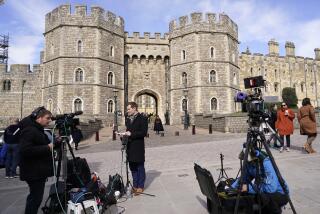BOOK REVIEW : Henry VIII’s Wives Granted New Life : THE WIVES OF HENRY VIII <i> by Antonia Fraser</i> , Knopf, $25; 512 pages
- Share via
Even now, marrying royals is a calculated risk, but at least the odds of surviving the experience have improved considerably during the last four centuries.
These days, if matters go badly, you’ll lose the perks but keep your head. Although four of the six wives of Henry VIII managed to keep theirs in place, only Anna of Cleves and Catherine Parr seemed to have enjoyed life after Henry.
Divorce, in fact, seems to have suited Anna better than marriage, and Catherine Parr lived to become Queen Dowager of England after Henry’s death. Catherine of Aragon was never able to accept the king’s rejection and remained inconsolable for the rest of her days.
Anne Boleyn, her notorious replacement, was unjustly accused of adultery after she failed to supply a male heir to the throne. Although there was virtually no evidence for the charge, she was found guilty and beheaded.
By then, King Henry had established the Church of England and had declared himself its earthly head, largely to facilitate his marital adventures. Once he no longer had to contend with the Vatican, acquiring fresh wives ceased to be a problem.
In order to ease his conscience and to dilute the stigma of having been cuckolded, King Henry was able to have his marriage with Anne Boleyn annulled. Therefore, when the swordsman of Calais severed Anne’s head, the king could declare that since she had never actually been his wife, she had not betrayed him. As face-saving measures go, it was both extraordinary and unnecessary, but then, Henry VIII was given to excesses of all sorts.
Jane Seymour, No. 3, died of septicemia only 12 days after presenting the king with his only male child. Had she lived, there would have been no need for Anna of Cleves, selected from a catalogue of eligible princesses by the king’s emissaries.
Unfortunately, Anna of Cleves was so profound a disappointment to the king that he found himself not only unable to consummate the marriage but totally uninterested in doing so.
“I like her not,” the king confided to Cromwell after his first glimpse of his new bride. He had, of course, seen portraits, but courtly portrait artists were apparently as skillful at flattery as Hollywood photographers.
When Anna’s attendants tactfully inquired about the events following the subdued wedding, the queen reported only a few tepid kisses and good wishes. “Madam, there must be more, or it will be long ere we have a Duke of York which all this realm most desireth.”
There was to be very little more before Henry found a more alluring object for his affections in young Katherine Howard. Anna of Cleves reigned for a mere six months before she was cast aside and sent off to a remote rural castle. She would shuttle from one to another of those until her death, all the while maintaining that she was the king’s dear sister, a role she seemed to relish. Although less prestigious by far, it was considerably safer than being queen.
Since one frail son, in that precarious era, was not enough to guarantee a Tudor succession, Katherine Howard was expected to fill the royal cradles. Despite her promise to be “bonair and buxom in bed,” she didn’t last long enough to meet expectations.
Married to a grossly fat man twice her age, she flirted recklessly with a young courtier said to have been a former lover. When the rumors of her infidelity became impossible to ignore, Henry VIII had but one recourse. A confession was extracted from Katherine Howard, and she was indicted for “having led an abominable, base, carnal, voluptuous and vicious life.”
Since deceiving the king was considered treason, not merely adultery, she was summarily sentenced to death by beheading. This time Henry did not bother to import the expert swordsman of Calais who had so neatly dispatched Anne Boleyn.
By now Henry VIII had so deteriorated physically that the field of candidates eager to be his next queen was drastically narrowed. Marrying Henry had been shown to be hazardous not only to health but to life itself.
Since failure to produce a male child was assumed to be the woman’s fault alone, chances of a new queen’s enjoying her eminence for long were discouraging. Word that Henry might be impotent had spread to all the courts of Europe, and even the most ambitious women shied away from his approaches.
But a king is still a king, and the twice-widowed Catherine Parr was willing to gamble that time might have mellowed her eminent suitor. Pious, submissive and skilled in the healing arts, Parr was not adverse to ministering to the ailing monarch. Rightly assuming that he might by now be more interested in a nurse than in a lover, she agreed to marry him. She was right in all essential respects and, within three years, Parr was the widow of the king of England, the most fortunate of the survivors.
Impeccably researched and gracefully written, “The Wives of Henry VIII” is crammed with contemporary insights. Accepting the formidable task of humanizing the six women who until now have been known more for their deaths than for their lives, Fraser has shown them to be models of courage and fortitude.
With the exception of Katherine Howard, who seems to have been no more than an aging tyrant’s plaything, the wives well deserve this respectful treatment. Re-examined and rehabilitated by the author, they seem martyrs to the notion that biology is destiny, sad proof that to be queen was to be the most vulnerable woman in the land.


